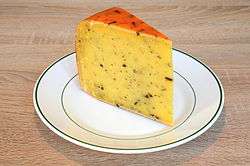Kanterkaas
Kanterkaas is a Dutch yellow cheese made from cow's milk. Apart from the plain variety, there is Kanterkomijnekaas which is flavored with cumin and Kanternagelkaas flavored with both cumin and cloves. Kanter is Dutch for 'edge' and refers to the sharp angle at the point where the side of the cheese wheel meets the base.[1] It was granted a Protected Designation of Origin by the European Union in 2000[2] and may only be produced in the province of Friesland and the Westerkwartier area.[1] The unprotected name Frisian clove cheese (Dutch: Friese nagelkaas or simply, Nagelkaas) is commonly used for other Dutch cheeses which are similar to Kanternagelkaas.
| Kanterkaas, kanterkomijnekaas, kanternagelkaas | |
|---|---|
 | |
| Country of origin | Netherlands |
| Region | Friesland, Westerkwartier |
| Source of milk | Cows |
| Pasteurised | Yes |
| Texture | Hard |
| Fat content | 20+: 20–25% 40+: 40–44% |
| Weight | 3 kg (6.6 lb) to 8.5 kg (19 lb) |
| Certification | PDO 2000 |
History
Production
Kanterkaas has a flat cylindrical shape. The edge between the side and the base is sharp, but rounded between the side and the top. Each cheese can weigh between 3 kg (6.6 lb) to 8.5 kg (19 lb).
The cheese is made in two fat content categories: 20+ and 40+. 20+ Kanterkaas contains a minimum of 20% and a maximum of 25% of fat in the dry matter. Twelve days after production, it must have a humidity content of not more than 48.5%. 40+ Kanterkaas has a fat content ranging between 40 and 44% in the dry matter. Twelve days after production, it must have a humidity content of not more than 41.5%. The rind of Kanterkaas and Kanternagelkaas may be 'natural' or treated with a colorless or yellow coating material. In addition to these a red coating material may be used for Kanterkomijnekaas.[1][3]
Taste
The taste of the cheese changes noticeably as it ages. Plain kanterkaas has a pleasant and sharp to strong flavor. Kanterkomijnekaas is fragrant, flavored, pleasant and mild to strong. Kanternagelkaas tastes fragrant, flavored, pleasant and sharp to strong.[1]
References
- "Publication of an application for registration pursuant to Article 6(2) of Regulation (EEC) No 2081/92 on the protection of geographical indications and designations of origin". Official Journal of the European Communities. European Commission. 42: C 378/2–4. 30 December 1999. Retrieved 12 March 2014.
- "Commission Regulation (EC) No 1903/2000". Official Journal of the European Communities. European Commission. 43: L 228/55–56. 8 September 2000. Retrieved 12 March 2014.
- The preceding sentences contain content from the European Commission and may be reused for commercial or non-commercial purposes provided the following attribution is present: © European Union, http://eur-lex.europa.eu/, 1998–2014.